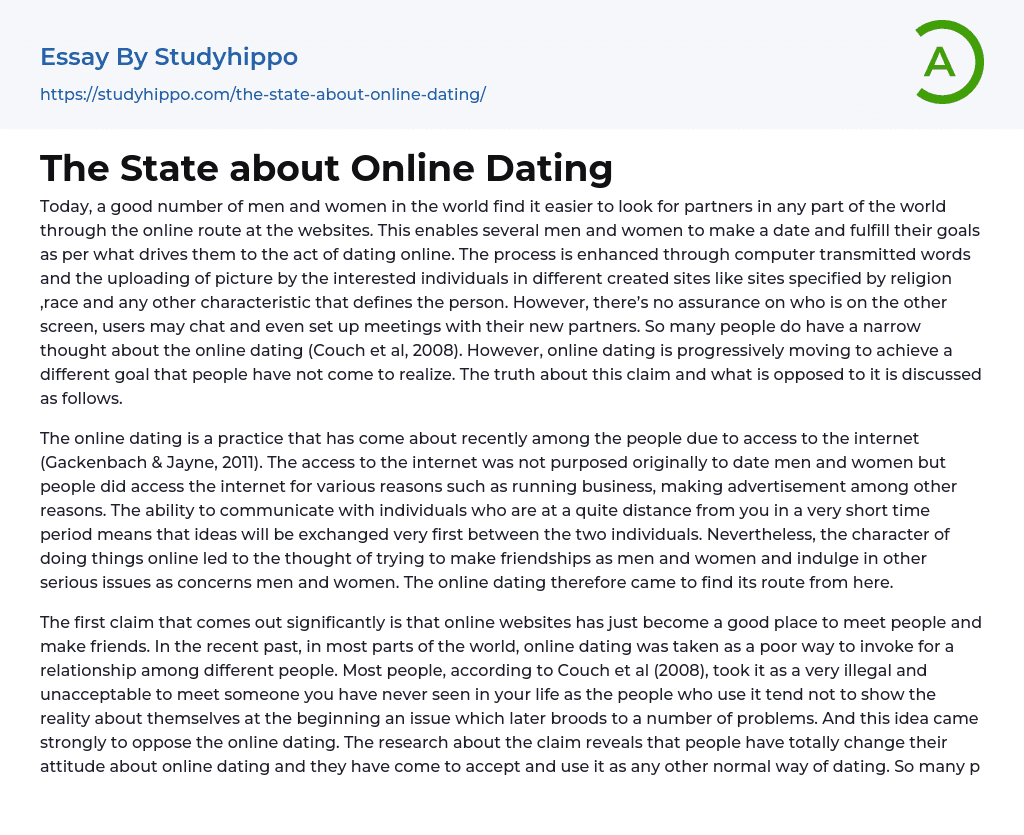Regardless of their location, people globally are increasingly choosing online platforms and websites to search for partners.
Online dating allows both men and women to utilize computer-mediated communication for organizing meetings and pursuing their objectives. They can upload pictures on websites that cater to specific qualities, such as religion or race. Nevertheless, it is crucial to acknowledge the uncertainty of the other person's identity behind the screen. However, users can still converse and even meet in person with their newfound partners. Although many people have a limited perspective on online dating (Couch et al, 2008), it is important to recognize its evolving nature towards an objective that may not be widely acknowledged. The subsequent passage examines this claim's true essence along with opposing viewpoints.
With the advent of the internet, online dating has gained popularity in recent times (Gackenbach & Jayne, 2011). Initially
...used for business and advertising, the internet enabled individuals to connect with people at a distance, presenting an opportunity for making friendships and pursuing romantic relationships online. Consequently, online dating emerged as a feasible choice for individuals seeking companionship and committed partnerships.
Online dating websites have become a popular platform for meeting and making friends, which contradicts the previous belief that online dating was considered inappropriate and deceitful. According to Couch et al (2008), many people saw it as illegal and unacceptable to form relationships with individuals they had never met before because online daters often misrepresented themselves initially, leading to various issues. However, recent research indicates that attitudes towards online dating have significantly shifted, and it is now accepted and used as a conventional method of dating. Numerous individuals have even shared their testimonies
endorsing its effectiveness, placing it on par with other approaches to finding love.
The text examines the popularity of online dating across different age groups. According to Toma et al (2008), a significant number of individuals who initiate romantic relationships on the internet achieve success through communication and picture sharing. This is especially prominent among those aged 20 to 30, comprising approximately eighty percent of online daters. For young adults, online dating offers a means of social connection, particularly for single individuals or college students seeking interaction with society.
Although a smaller proportion of older individuals utilize online dating, this could be attributed to their introverted nature and preference for virtual interactions rather than face-to-face meetings. Valkenburg (2007) suggests that some older people may turn towards dating websites as a way to overcome shyness or nervousness. Furthermore, married individuals who have undergone divorce, experienced the loss of a spouse, or desire new experiences may also explore online dating.
In contrast, younger people possess the opportunity to establish meaningful connections with their peers and should seize this chance. It is imperative for them to make prudent choices in their relationships while navigating the realm of dating.
This text emphasizes the benefits of online dating in terms of improving relationships and addressing future issues among spouses. It highlights that many individuals who date online are able to physically meet their online connections, although it acknowledges the challenges of organizing in-person meetings with partners who may still be married or engaging in online dating for fun. The text also mentions that about twenty-seven percent of people who engage in online dating do not succeed in meeting their online dates, possibly due to
factors like geographical location and financial capabilities (Hancock & Toma, 2009).
According to a study by Ellison et al (2006), individuals who participate in online dating put in substantial effort into crafting an appealing profile with the goal of attracting potential partners. They employ enticing photographs, some of which may not be their own, to enhance their appeal. Both men and women engage in this behavior, although research suggests that women tend to do it more frequently than men, at a rate of approximately thirty percent compared to men. However, it is essential to acknowledge that many people worldwide who are happily married claim they met their spouse without utilizing online dating. As stated by Ellison et al (2006), about eighty percent of the population falls within this category, while only twenty percent met their spouse through online means.
Online dating poses a significant challenge when it comes to connecting with someone who is separated by a great distance. This effectively contradicts the concept of online dating. While online dating has both pros and cons, similar to other dating methods, this forms the basis for both supporting and opposing opinions on online dating. The only advantage is that some individuals may be attracted to wealthy partners who have experienced failed marriages and are seeking new spouses. However, the drawbacks include meeting people with different preferences and unexpected expenses associated with dating. In summary, online dating has become a widespread reality used by people worldwide to find potential life partners.
- Adoption essays
- Aunt essays
- Babies essays
- Bedroom essays
- Caring essays
- Children essays
- Daughter essays
- Divorce essays
- Dog essays
- Dysfunctional Family essays
- Family Tradition essays
- Family Values essays
- Father essays
- Foster Care essays
- Friends essays
- Grandparent essays
- Home essays
- Hometown essays
- Husband essays
- Jealousy essays
- Love essays
- Marriage essays
- Mother essays
- Online Dating essays
- Parenting essays
- Parenting Teens essays
- Parents essays
- Relationship essays
- Room essays
- Sibling essays
- Sister essays
- Wedding essays
- Wife essays




